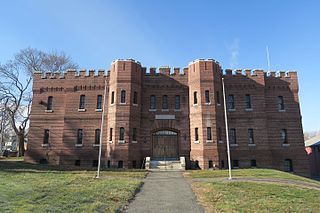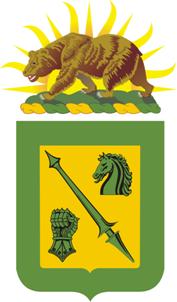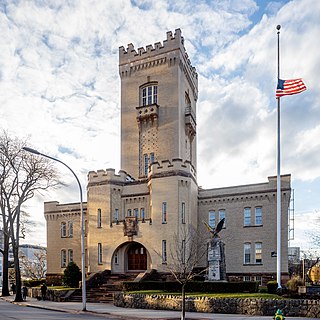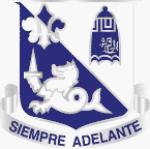
The 40th Infantry Division is a modular division of the United States Army. Following the army's modularization the division has become a four-brigade combat team with National Guardsmen from throughout the Pacific/Western United States and Oceania. Its division headquarters is located at Los Alamitos Joint Forces Training Base in Los Alamitos, California.

Exposition Park is a 160-acre urban park (65 ha) in the south region of Los Angeles, California, in the Exposition Park neighborhood. Established in 1872 as an agricultural fairground, the park includes the Los Angeles Memorial Coliseum, BMO Stadium, the California Science Center, the Natural History Museum of Los Angeles County, and the California African American Museum. The Lucas Museum of Narrative Art is under construction. Bounded by Exposition Boulevard to the north, South Figueroa Street to the east, Martin Luther King Jr. Boulevard to the south and Vermont Avenue to the west, it is directly south of the main campus of the University of Southern California.

The California Science Center is a state agency and museum located in Exposition Park, Los Angeles, next to the Natural History Museum of Los Angeles County and the University of Southern California. Billed as the West Coast's largest hands-on science center, the California Science Center is a public-private partnership between the State of California and the California Science Center Foundation. The California Natural Resources Agency oversees the California Science Center and the California African American Museum. Founded in 1951 as the "California Museum of Science and Industry", the Museum was remodeled and renamed in 1998 as the "California Science Center". The California Science Center hosts the California State Science Fair annually.

The Arizona Army National Guard is a component of the United States Army and the United States National Guard. National coordination of various state National Guard units are maintained through the National Guard Bureau.

The California Army National Guard is one of three components of the California National Guard, a reserve of the United States Army, and part of the National Guard of the United States. The California Army National Guard is composed of 18,450 soldiers. Nationwide, the Army National Guard comprises approximately one half of the US Army's available combat forces and approximately one third of its support organization. National coordination of various state National Guard units are maintained through the National Guard Bureau.

The Hudson Armory is a former Massachusetts Army National Guard armory and training center located at 35 Washington Street in Hudson, Massachusetts, United States. It is a castle-like, two-story brick masonry building built in 1910 at the intersection of Park Street and Washington Street in Hudson along the Assabet River. It was originally constructed for the Massachusetts Volunteer Militia. It was designed by architects James E. McLaughlin and James Mulcahy. As of June 2021, there are plans to convert the currently vacant armory into a community arts center.

The 185th Infantry Regiment is a unit of the United States Army made up of soldiers from the California Army National Guard, represented by the 1st Battalion, part of the 81st Stryker Brigade Combat Team.

The 18th Cavalry Regiment is a parent cavalry regiment of the United States Army.

The Sergeant First Class John H. Newnam Armory, also known as the Chestertown Armory, is a historic National Guard armory built in 1931 and located in Chestertown, Kent County, Maryland, United States. From 1933 until 2005 it housed various formations from the Maryland Army National Guard. It also was the home of sporting and community events during this time. After the 115th Infantry Regiment was merged into the 175th Infantry Regiment in 2005, the armory was declared to be surplus by the state of Maryland. The Chestertown Armory was transferred to Washington College in 2013. Since then, it has stood vacant. The college is investigating the possibility of turning it into a bed and breakfast.

A National Guard Armory, National Guard Armory Building, or National Guard Readiness Center is any one of numerous buildings of the U.S. National Guard where a unit trains, meets, and parades. A readiness center supports the training, administration, and logistics of National Guard units by providing assembly space, classrooms, weapons and protective personal equipment storage, and training space. Readiness centers can also be utilized as communal assembly areas, utilized by local organizations and governments.

The 369th Regiment Armory is a historic National Guard Armory building located at 2366 Fifth Avenue, between West 142nd and 143rd Streets, in Harlem, Manhattan, New York City. It was built for the 369th Regiment, also known as the "Harlem Hell Fighters", founded in 1913 as the first National Guard unit in New York State composed solely of African-Americans. It later became home to the 369th Sustainment Brigade.

The 160th Infantry Regiment is an infantry regiment of the United States Army. The 1st Battalion, 160th Infantry is a light infantry component of the 79th Infantry Brigade Combat Team (IBCT).
The 185th Armor Regiment was an armor regiment of the United States Army consisting of soldiers from the California Army National Guard.

The White Plains Armory is a historic building in White Plains, New York, in Westchester County.

Lieutenant General Herbert R. Temple Jr. is a career military officer who served as Chief of the National Guard Bureau.

Charles Alling Gifford was an American architect and a partner in the New York City firm of Gifford & Bates. He is best remembered for his resort hotels, but also designed houses, churches, and five armories for the New Jersey National Guard.

The 223rd Infantry Regiment is a regiment of the United States Army. The regiment was part of the California Army National Guard, and had Soldiers from the Los Angeles metropolitan area. Three members of the 223rd Infantry Regiment were awarded the Medal of Honor for their actions during the Korean War: David B. Bleak, Gilbert G. Collier and Clifton T. Speicher.

The Armory Center for the Arts, also known as the Armory, is a 501(c)(3) nonprofit visual arts organization located in Pasadena, California. The Armory provides community arts education programs for all ages and exhibitions of contemporary art, most of which are offered at no cost. Founded in 1989, the organization is housed in a renovated California National Guard Armory, from which its name is derived.

The St. Peter Armory is a former National Guard Armory in St. Peter, Minnesota, United States. Built from 1912 to 1913, it is one of the oldest armories still standing in Minnesota and was the first one to be owned by the state upon its completion. It was designed in a restrained Gothic Revival style which captures a transition in Minnesota armory design from heavy, fortresslike buildings to the simpler designs of the 1920s. It was listed on the National Register of Historic Places in 1997 for having local significance in the themes of architecture, military history, and social history. It was nominated for being an excellent example of Minnesota's pre-World War I armories, as well as for its early status, transitional architecture, and role in St. Peter as a center not only of military affairs but also social and recreational events.




















